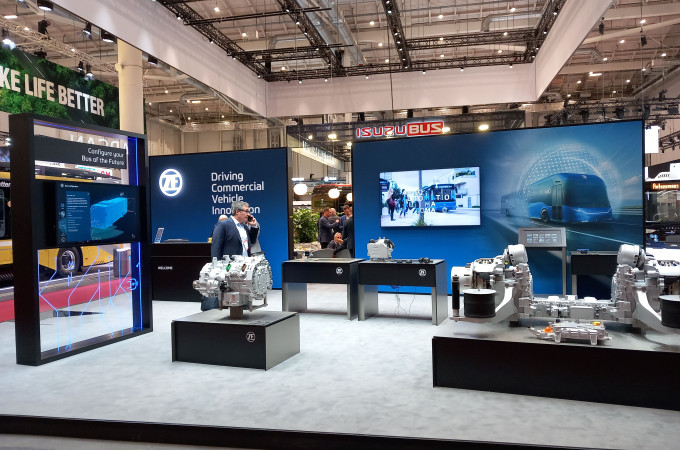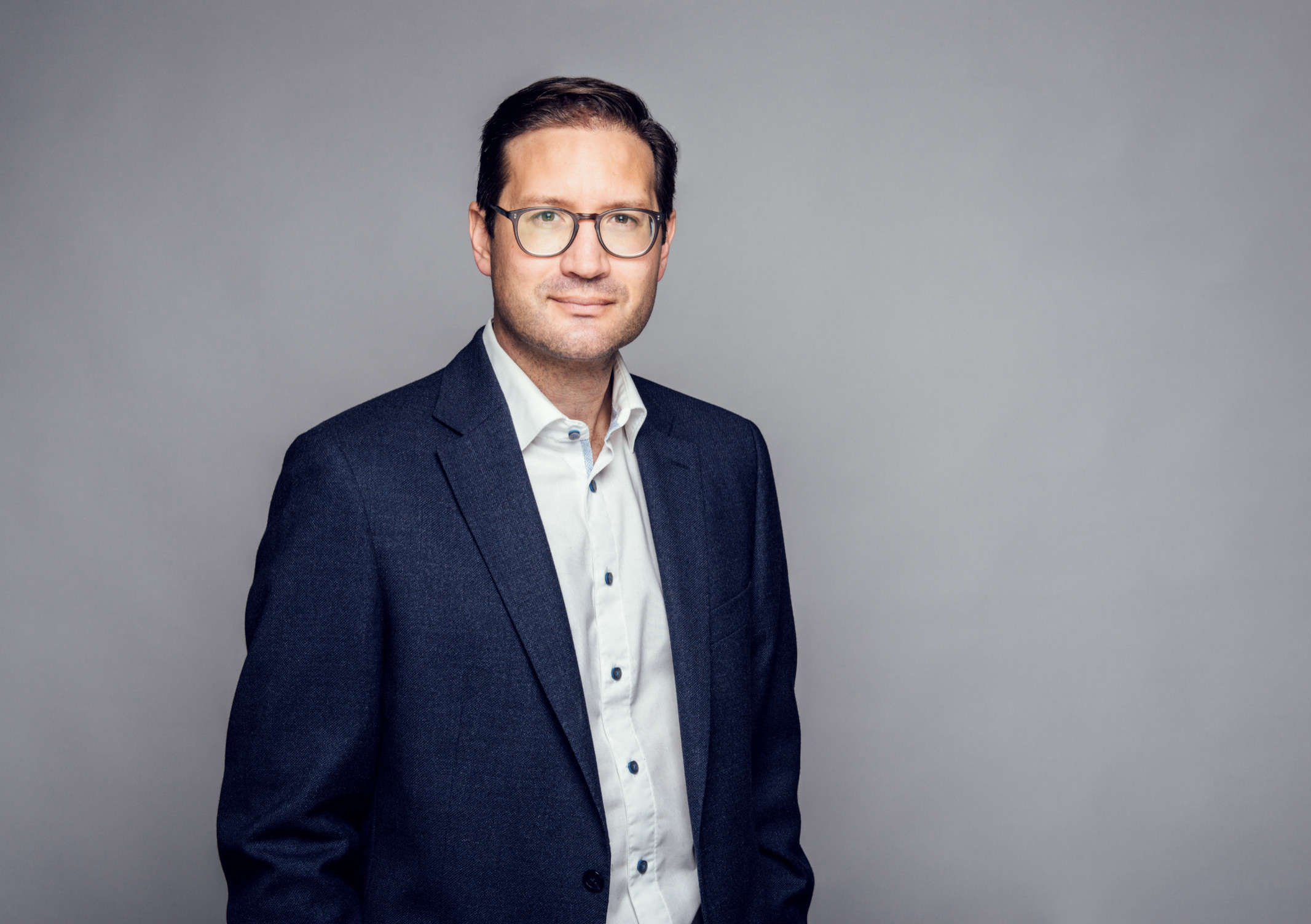UITP 2025: Daniel Majewski explains how ZF’s products are making Europe’s public transport safer and more efficient
By Bradley Osborne - 7th August 2025

ZF's stand at UITP Summit 2025 in Hamburg
Germany – The AxTrax low-floor and CeTrax 2 electric drives; OnGuard Max; Collision Mitigation System; E-comp scroll air compressor; BusConnect. These are just some of the many products and services which the German company ZF has developed over the years, and all of these were on show at the UITP global summit in Hamburg, held between 15-18 June. Making these products and implementing them in buses has required a broad range of people with different competencies and specialisms; however, it takes one unit to promote them together with the regional sales and tailor them to people transportation. Truck & Bus Builder spoke with Daniel Majewski, Global head of Bus Solutions at ZF, about what makes the bus segment unique, how ZF supports manufacturers in keeping up to speed with the latest regulations and technologies, and how the implementation of new products and services is making Europe’s public transport safer and operational efficient.
We began our conversation, however, on the caveat – notwithstanding the excellent performance of the global bus market since the COVID-19 pandemic – that the bus segment is much smaller than truck and cannot generate the economies of scale needed to justify high levels of dedicated investment. Naturally, many of the technologies which ZF has developed for buses began as products for the truck segment, where the greater volume allows for the scales required to pay returns on investment. With each new product that is developed for trucks, ZF’s bus team plan adaptations that can cater for the oftentimes more complex and demanding needs of public transport operators. Being matched up with truck development is an undoubted advantage for ZF’s bus solutions, allowing it to leverage technologies at scales that would otherwise be very difficult to achieve. On the other hand, adapting truck products to the bus segment invariably requires additional investments of time and money, and Majewski acknowledges that the company has to make its decisions over where to invest under the constraint of limited resources.
One example of this kind of development is the AxTrax 2 LF, a new electric portal axle designed to replace the AxTrax AVE model. ZF says the new axle consumes approximately 20% less electrical energy in the SORT cycle compared to its predecessor, helping to reduce operational costs as well as the total cost of ownership. Operators can benefit from greater flexibility, too: they can either order a bus with smaller and less expensive battery packs or opt for a configuration with a higher potential range. These energy savings are driven by advancements in electric drive components, which stem from ZF’s electric drive platform developed for commercial vehicles. The company also says that its new CeTrax 2 electric central drive also shows strong potential for efficiency saving as well.
In its organisation, ZF’s bus division mirrors the trailer division rather than truck. Whereas ZF’s truck business is split between three product lines – driveline, safety systems, and other components and subsystems such as compressors – its trailer business is unified in a single unit that is dedicated to the end product. When, in 2022, ZF merged its two commercial vehicle divisions into the current CVS (“Commercial Vehicle Solutions”) business unit, it had a disparate range of products and technologies under its name, some of which had come from acquired businesses such as WABCO. Indeed, it was through joining WABCO in 2017 that Majewski ended up working for ZF. Following the internal merger, ZF consciously reorganised its bus products on the same lines as the trailer business: a single, dedicated segment responsible for bus and coach – primarily its EcoLife transmission and conventional axles – while also overseeing other products designed for the bus and coach industry. Majewski plays a coordinating role across this portfolio, acting and ensuring alignment and focus on delivering end-to-end solutions for the industry’s diverse customer groups.
Why is it important that ZF’s business be organised in this way? There are two reasons. The first is that the expectations of the customer are very different between the truck and bus segments. Whereas large truck manufacturers may pick and choose what components and subsystems they want from ZF and carry out the integration themselves, the bus manufacturers – more often mid- and small size businesses – take whole systems and require substantial help in integrating them into their vehicles. In fact, ZF’s systems integration support often extends to homologation, helping the bus manufacturers acquire the approvals needed to put a new model on the road.
As buses incorporate more and more software, the manufacturers become increasingly reliant on ZF for help.
If a manufacturer is taking components and systems from many different suppliers, these won’t be easy to connect, and the company will struggle to fix the problem on its own, especially if they are small,
Majewski told T&BB. The buses of the near future will receive frequent over-the-air updates, requiring service capabilities and cybersecurity that many manufacturers will be unable to provide on their own. “In my view, the suppliers will have an important, relevant role to support all the manufacturers [on this],” Majewski said.
The second reason why ZF’s bus products are coordinated under one division is that, as transportation becomes more digitised, the bus segment will diverge further from the truck segment. Urban transport will become increasingly “intermodal”, allowing the passenger to travel by several means (metro, tram, train, bus) using a single service and with a single ticket; this means that buses will need to interface with other transport systems. Majewski also cited other surprising uses to which buses can be put by local operators. For instance, he mentioned that New York City is using bus cameras – ostensibly there to assist the driver – to identify and report parking violations. The buses of the future will become nodes in a “city observation” network “where [local operators] bring all the data points together to optimise ease of traffic, maintenance of roads, and infrastructure.”

ZF AxTrax 2 LF low floor e-axle
ZF’s stand at UITP 2025: bus products and services
Bus manufacturing is an increasingly expensive business, and with more regulations to comply with and new technologies to integrate, it is likely to become even more costly. As ZF’s obligations as a supplier evolve, requiring it to provide more and more integration support to manufacturers, so the final bill of materials also changes.
If you look into the bill of materials, the factor of system integration is going up […] This will become a continued increased complexity and evolution for the next ten to fifteen years,
Majewski told T&BB.
In addition to integration support, ZF is also focusing on technologies that directly reduce operational costs for bus operators. ZF’s concept of a city bus assist is saving money on expenses that arise from minor damages to the tyres and to the bus panelling. Every time a bus pulls up to a stop, there is a risk of damage from curb impact. Replacing a tyre can cost the operator between three to four hundred euros; the cost of repairing the accumulated minor damages sustained by a typical bus can cost as much as twenty to forty thousand euros. With its advanced driver assistance systems, ZF can reduce not only costs and optimizes the passenger flow on top– bus operators are already showing interest in this system, according to Majewski.
Other solutions are focused on passenger safety and comfort. ZF’s ‘Collision Mitigation System’ avoids applying a hard brake straightaway in an emergency scenario, instead giving a small “pulse” or “jerk” to warn the passengers and give them time to grab a handrail or sit down before a harder brake is applied. The point is to prevent cases where passengers are injured when the bus has to brake suddenly.
Leaning more on the side of passenger comfort is ZF’s new compressor which was debuted in North America at the Advanced Clean Transportation Expo. Entering production in Europe in 2027, the e-comp Scroll air compressor is a “highly flexible and highly demanded” addition to the electric bus, according to Majewski. As the operation of the electric driveline is so much quieter, the noise coming from the compressors is more noticeable and therefore more annoying to passengers. ZF’s new scroll-design reduces noise to around 67dB(A) at the nominal operation point of 250 litres per minute and also reduces vibration. It is also oil free, removing the possibility of damage due to oil leakage and reducing the expense required to keep it serviced.
Majewski told T&BB that the company is “in close contact” with operators to learn more about the savings that are being realised with the rollout of ZF’s latest products and services. The company’s portfolio of advanced driver assistance systems, designed to ensure a vehicle’s compliance with the European Union’s newest General Safety Regulation, can also bring operational benefits such as fewer costs related to accidents and vehicle repair and greater uptime. Majewski said that the EU is currently evaluating the impact of GSR II since it was introduced in July 2024, but ZF is already developing a new generation of systems which will be launched in three years’ time.

Daniel Majewski is Global head of Bus Solutions at ZF, a position he has held since the beginning of 2024. He started working for ZF’s former subsidiary, WABCO, in 2017 as head of marketing and business development for truck and bus. Prior to joining ZF, Majewski worked for Eaton in various industry sectors including oil and gas, chemicals, and renewables. He began his career at General Electric and has also worked for Philips.



-of-Knorr-Bremse-AG.jpg?w=400&h=225&fit=crop)